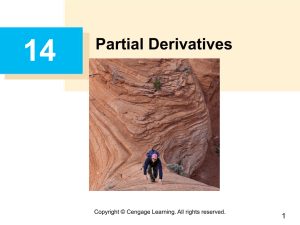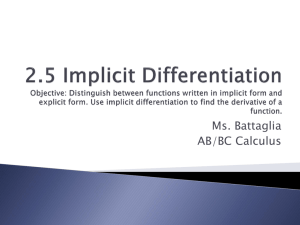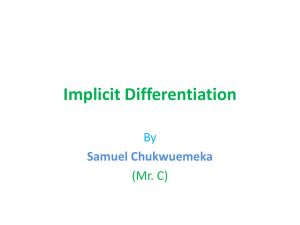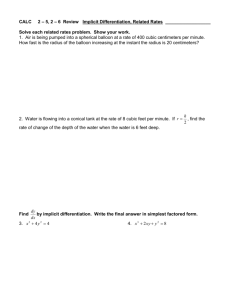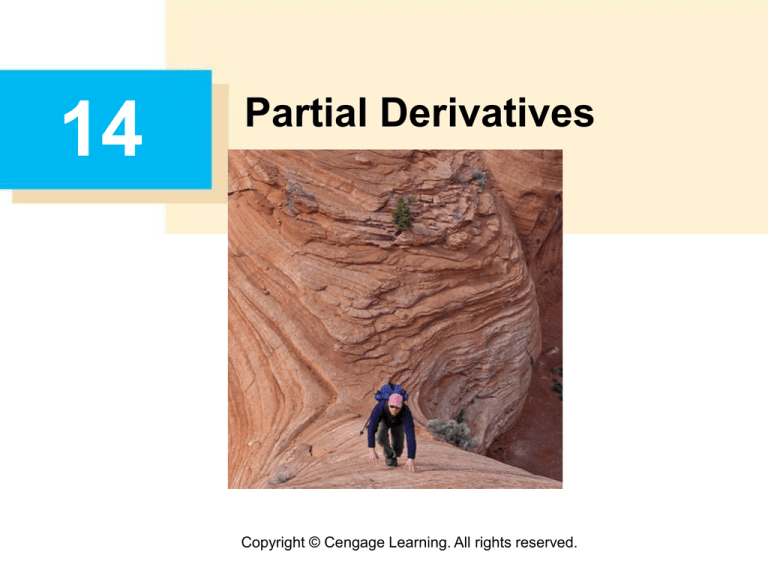
14
Partial Derivatives
Copyright © Cengage Learning. All rights reserved.
14.5
The Chain Rule
Copyright © Cengage Learning. All rights reserved.
The Chain Rule
Recall that the Chain Rule for functions of a single variable
gives the rule for differentiating a composite function:
If y = f(x) and x = g(t), where f and g are differentiable
functions, then y is indirectly a differentiable function of t
and
For functions of more than one variable, the Chain Rule
has several versions, each of them giving a rule for
differentiating a composite function.
3
The Chain Rule
The first version (Theorem 2) deals with the case where
z = f(x, y) and each of the variables x and y is, in turn, a
function of a variable t.
This means that z is indirectly a function of t,
z = f(g(t), h(t)), and the Chain Rule gives a formula for
differentiating z as a function of t.
4
The Chain Rule
We assume that f is differentiable. Recall that this is the
case when fx and fy are continuous.
Since we often write ∂z/∂x in place of ∂f/∂x, we can rewrite
the Chain Rule in the form
5
Example 1
If z = x2y + 3xy4, where x = sin 2t and y = cos t, find dz/dt
when t = 0.
Solution:
The Chain Rule gives
= (2xy + 3y4)(2 cos 2t) + (x2 + 12xy3)(–sin t)
It’s not necessary to substitute the expressions for x and y
in terms of t.
6
Example 1 – Solution
cont’d
We simply observe that when t = 0, we have x = sin 0 = 0
and y = cos 0 = 1.
Therefore
= (0 + 3)(2 cos 0) + (0 + 0)(–sin 0)
=6
7
The Chain Rule
We now consider the situation where z = f(x, y) but each of
x and y is a function of two variables s and t:
x = g(s, t), y = h(s, t).
Then z is indirectly a function of s and t and we wish to find
∂z/∂s and ∂z/∂t .
Recall that in computing ∂z/∂t we hold s fixed and compute
the ordinary derivative of z with respect to t.
Therefore we can apply Theorem 2 to obtain
8
The Chain Rule
A similar argument holds for ∂z/∂s and so we have proved
the following version of the Chain Rule.
Case 2 of the Chain Rule contains three types of variables:
s and t are independent variables, x and y are called
intermediate variables, and z is the dependent variable.
9
The Chain Rule
Notice that Theorem 3 has one term for each intermediate
variable and each of these terms resembles the
one-dimensional Chain Rule in Equation 1.
To remember the Chain Rule, it’s helpful to draw the tree
diagram in Figure 2.
Figure 2
10
The Chain Rule
We draw branches from the dependent variable z to the
intermediate variables x and y to indicate that z is a
function of x and y. Then we draw branches from x and y to
the independent variables s and t.
On each branch we write the corresponding partial
derivative. To find ∂z/∂s, we find the product of the partial
derivatives along each path from z to s and then add these
products:
11
The Chain Rule
Similarly, we find ∂z/∂t by using the paths from z to t.
Now we consider the general situation in which a
dependent variable u is a function of n intermediate
variables x1, …, xn, each of which is, in turn, a function of m
independent variables t1,…, tm.
Notice that there are n terms, one for each intermediate
variable.
12
The Chain Rule
13
Implicit Differentiation
14
Implicit Differentiation
The Chain Rule can be used to give a more complete
description of the process of implicit differentiation. We
suppose that an equation of the form F(x, y) = 0 defines y
implicitly as a differentiable function of x, that is, y = f(x),
where F(x, f(x)) = 0 for all x in the domain of f.
If F is differentiable, we can apply Case 1 of the Chain Rule
to differentiate both sides of the equation F(x, y) = 0 with
respect to x.
Since both x and y are functions of x, we obtain
15
Implicit Differentiation
But dx/dx = 1, so if ∂F/∂x ≠ 0 we solve for dy/dx and obtain
To derive this equation we assumed that F(x, y) = 0 defines
y implicitly as a function of x.
16
Implicit Differentiation
The Implicit Function Theorem, proved in advanced
calculus, gives conditions under which this assumption is
valid:
It states that if F is defined on a disk containing (a, b),
where F(a, b) = 0, Fy(a, b) ≠ 0, and Fx and Fy are
continuous on the disk, then the equation F(x, y) = 0
defines y as a function of x near the point (a, b) and the
derivative of this function is given by Equation 6.
17
Example 8
Find y if x3 + y3 = 6xy.
Solution:
The given equation can be written as
F(x, y) = x3 + y3 – 6xy = 0
so Equation 6 gives
18
Implicit Differentiation
Now we suppose that z is given implicitly as a function
z = f(x, y) by an equation of the form F(x, y, z) = 0.
This means that F(x, y, f(x, y)) = 0 for all (x, y) in the
domain of f. If F and f are differentiable, then we can use
the Chain Rule to differentiate the equation F(x, y, z) = 0 as
follows:
19
Implicit Differentiation
But
and
so this equation becomes
If ∂F/∂z ≠ 0, we solve for ∂z/∂x and obtain the first formula
in Equations 7.
The formula for ∂z/∂y is obtained in a similar manner.
20
Implicit Differentiation
Again, a version of the Implicit Function Theorem gives
conditions under which our assumption is valid:
If F is defined within a sphere containing (a, b, c), where
F(a, b, c) = 0, Fz (a, b, c) ≠ 0, and Fx, Fy, and Fz are
continuous inside the sphere, then the equation
F(x, y, z) = 0 defines z as a function of x and y near the
point (a, b, c) and this function is differentiable, with partial
derivatives given by (7).
21

